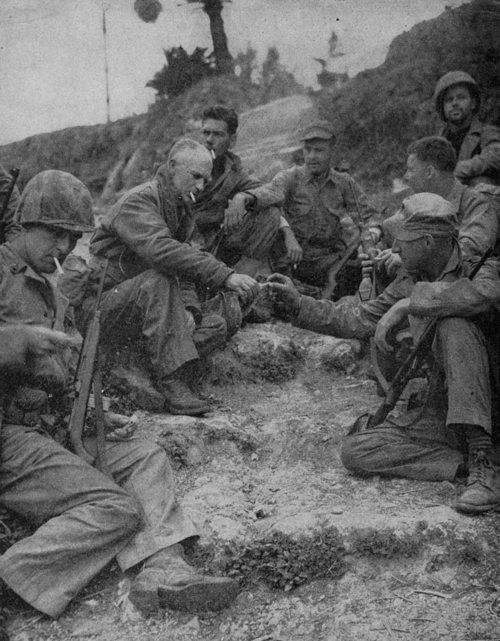Ernie Pyle
War Correspondent

Click photo to enlarge. Click "Back" to return
I think that I will not be in error to surmise that the majority of Americans under the age of 40 years have never heard of Ernie Pyle much less know of his historic writings for the Scripps Howard newspapers during the Second World War. More than three hundred papers across the nation carried the writings of this diminuitive reporter.
He became a household name during his exploits in Europe as he brought home to America the real-life experiences of the American fighting soldier. He lived among them, ate what they ate, marched where they marched and eventually died where they died - on a small island off the northern west coast of Okinawa. I might further venture a bet that those same Americans under the age of 40 know very little - if anything at all - about Okinawa and the devastating final battle of World War II.
Ernie was an unassuming homey kind of guy, not large in stature but towering in heart. He loved the American soldier and made it his mission to tell the folks back home what their boys were going through, even if it broke their hearts to read his accounts.
Pyle was born and raised in the tiny Indiana town of Dana. He was a member of the US Naval Reserve and served on active duty during the last three months of the First World War. After the war he pursued his career as a journalist. While managing editor of The Washington (D.C.)Daily News he met and married Geraldine Siebolds.
Returning to his job in 1934 after a long vacation he was called upon to write columns for an absent syndicated journalist, Heywood Broun. Before he had published fewer than a dozen columns he had become "a hit" across the country and his name was known far and wide. In 1935 he was given an opportunity to tour the U.S. and write about the things he found and the folks he met along the way. (Some of those articles were organized and published after his death in the book Home Country.) Ernie continued writing a daily column detailing his travels until the U.S. entered the war in 1942.
As did the nation and its soldiers, Pyle joined the fight as a war correspondent. He traveled with the troops, lived with the troops and depicted their daily lives in his press columns. At one point in 1944 he mused in his column that the ground-pounding soldiers should get "fight pay" just the same as aviators were getting "flight pay". What followed was Congressional legislation called "The Ernie Pyle Bill" that garnered a combat soldier an extra $10.00 a month in his pay.









